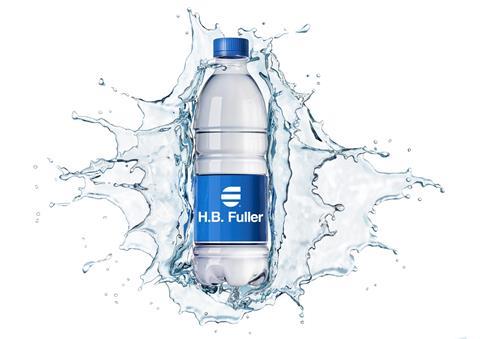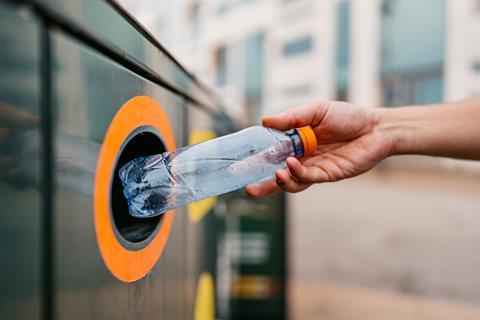In the first of our two Wider View articles with H.B. Fuller this year, we ask what is behind the lack of high-quality rPET for bottles on the market, delve into the regulatory context and – most importantly – explain why choosing the right adhesives, such as the recently launched H.B. Fuller® Earthic™ 4001, is crucial to achieving circularity targets.
The current regulatory landscape for rPET and plastics circularity clearly shows why making the right choices in packaging design - especially when it comes to adhesives - can pay dividends down the road. The provisional deal on the Packaging and Packaging Waste Regulation (PPWR) reached by The European Parliament and Council presidency in early March has reaffirmed the 2030 and 2040 targets for recycled content in plastic packaging. This is good news for the industry, as Elizabeth Staab, Global Packaging Sustainability Manager at H.B. Fuller, tells us.
“Mandatory quotas for Post Consumer Recycling (PCR) in packaging as outlined in the PPWR will provide more forecasting security for recyclers to invest in state-of-the-art infrastructure. Mandatory use of PCR will be a market requirement in the EU rather than a voluntary commitment.”
Yet there is still an insufficient amount of high-quality, food-contact grade rPET across the continent. Why is this?
Historically, a significant amount of Europe’s plastic waste has been exported and this has arguably hindered the development of better sorting, collection, and recycling infrastructure on the continent.

“2023 was a really tough year economically for PET recyclers in Europe; a couple of plants were even shut down” explains Elizabeth Staab. “Although many brands and retailers have made public commitments to using rPET in their beverage packaging, these are still voluntary and set for 2025.”
To address this, and to increase the focus on utilizing home-generated plastic waste to meet the terms of the European Green Deal and PPWR, the EU severely restricted the shipment of plastic waste from EU to non-OECD countries.
But conversely, there have also been increased imports of rPET from China and Turkey in recent years. While this might at first glance appear to be a positive, it can be detrimental to the EU’s creating a robust circular economy for plastics of its own. Therefore, in November 2023 the Commission imposed provisional anti-dumping duties on imports of certain PET products from China.
The vital role of adhesives
This is the wider context; but clearly, meeting the increased demand for rPET creates challenges for brand owners and converters (light weighting, barriers, monomaterials and machinability are just some that spring to mind). What can be done to meet these and – more importantly for the purposes of this article – what role do adhesives play in ensuring the circularity of bottle-to-bottle recycling? Labels, after all, are a vital part of the package: not only do they provide safety and recyclability information for consumers; they also enable brand differentiation in a very crowded global marketplace. The right choice of adhesive is key to generating high-quality rPET.
“The right choice of adhesive is key to generating high-quality rPET.”
“The cleaning of PET bottles is an essential step of the PET recycling process when any remaining liquids, labels, adhesives, and any other impurities need to be removed,” explains Elizabeth. “Thus, an easy and effective label removal and wash-off adhesives are paramount to a state-of-the-art recycling process. Adhesives for wrap-around and full surface labels that wash-off easily in the recycling process assist the overall process and enhance the quality of rPET.”
H.B. Fuller® Earthic™ 4001 is a case in point: a wrap-around labelling grade for plastic labels on PET bottles, part of a global alkali washable product line. Labels are removed and separated from the PET bottles to allow for efficient regranulation and the production of new pre-forms. According to H.B. Fuller, it is suitable for labelling speeds of up to 37,000 bottles per hour.
“Good flexibility of the H.B. Fuller® Earthic™ 4001 keeps the label in place on all types of beverages including highly carbonated soft drinks across a wide temperature range. The very light colour means the adhesive is barely visible on the label and bottle, meeting the highest standards for brand integrity and label appearance. Also, within this product line, the H.B. Fuller® Earthic™ 4010N has recently received Association of Plastic Recyclers’ Design® for Recyclability Recognition for alkali wash-off for the North American market.”
On the other hand, choosing the wrong adhesive can actively hinder the recycling process. “If an adhesive does not permit efficient label removal during this initial step, the label and adhesive may contaminate further processing steps and the rPET itself, leading to spots or discoloration in the rPET. Hence, the importance of correct selection of wash-off adhesives for PET labelling, whether wrap-around or full surface adhesive labels. However, wrap-around labels are the most common, roughly 90% for beverages, and only minimal amounts of adhesive are needed to keep the label in place.”
It should be remembered that the market for food and beverage packaging is constantly evolving, with new materials, pack designs and sustainability requirements all obliging brand owners and producers to stay agile, as Elizabeth points out.
“While manufacturers seem to be reaching the limit with regards to ultra-thin PET bottles, we still see changes in label stock to which adhesives need to adapt. Inks do not tend to be an issue for adhesives as the printed surface area in contact with adhesives on wrap-around labels is minimal. New packaging designs in multipacks need adhesive innovations and we are working with several industry partners and customers to develop new designs and bring them to market.”

Meeting the food contact grade
The challenge with recycling does not just come down to the aesthetic appearance of the rPET: far more significant are the safety concerns. While there has been much talk about the possibilities of chemical recycling for increasing the range of food contact-grade plastics, at present, mechanical recycling is still the most widely used method. In fact, within bottle-to-bottle recycling, this is the only recycling process approved for direct food contact in Europe, further emphasizing the need for easily removable adhesives such as those in the Earthic™ range. According to figures by Plastic Recyclers Europe, the sorted for recycling rate for PET beverage bottles was estimated to be 75% in 2022, compared to 61% in 2020. How is this being achieved?
“Clean, separate collection allows for best possible results in the recycling process generating high quality rPET,” explains Elizabeth. “DRS (deposit return schemes) have been proven to be the most effective measure for separate, efficient collection with some countries achieving over 90% collection rates. With the introduction of the PPWR, all EU countries need to implement a DRS unless they already have a similarly effective system in place.”
It is here that the industry can play an important role, through cross-value chain initiatives such as RecyClass, in ensuring that requirements and testing standards for plastic recycling are objective, science-based and technically feasible for adhesives.
Advice for brand owners
So far, we’ve looked at the changing legislative environment and the general challenges companies face in adapting to this. But in practical terms, if a beverage producer is planning to embark on a product redesign, what should they consider? We asked Elizabeth what advice she would give.
“First, understanding the regulatory framework, especially for international operators can be a challenging exercise and the minimum legal requirements need to be well understood. How legal standards evolve and the brand’s commitments to changing plastics’ use, i.e. EMF pledges, should be well mapped and laid out to finetune the existing strategy.”
“From an adhesive point of view, we recommend involving all material suppliers early in the packaging design process as 80% of the carbon footprint of a package is determined in the design phase. Our technical team can make product recommendations based on existing or future machine constellations use and recycling requirements when wash-off labelling adhesives, such as the Earthic™ product range, may be required. In some cases, we embark on the journey of developing a new package design or adhesive with other supply chain partners to support customers and their sustainability goals.”
“Our technical team can make product recommendations based on existing or future machine constellations use and recycling requirements when wash-off labelling adhesives, such as the Earthic™ product range, may be required.”
Meeting rPET targets is going to be a challenging and complex task for all companies involved in the value chain, but in the case of adhesives at least it is relatively simple: choosing the right wash-off adhesive can ensure your bottles are recyclable, which in turns allows you to effectively source rPET for new PET bottles. Sometimes the seemingly smallest things can make the biggest difference.

This premium feature brings a completely new way for you to interact with our audience through a combination of collaborative editorial and premium promotion. An article written together between you and Packaging Europe’s content team, The Wider View will have a dedicated widget across all web pages & eNewsletter, and will link to a stunning, long-format web page put together by our design team featuring your graphics and branding. Carrying no other advertising, and pushing the limits of ordinary web communications, this is the ultimate digital content package.














No comments yet